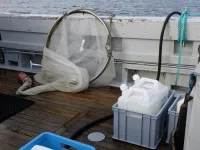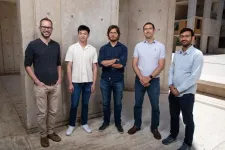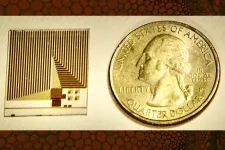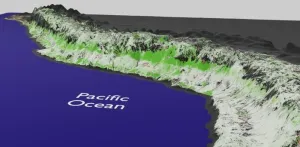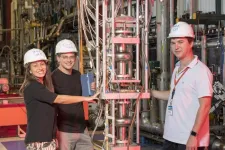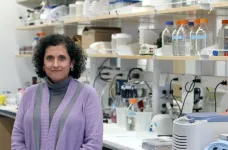(Press-News.org) Researchers at a field site in Victoria, Australia are among the first to use fiber optic distributed acoustic sensing (DAS) for high-precision tracking of induced seismicity from a small carbon dioxide (CO2) injection, according to a new study published in Seismological Research Letters.
The CO2CRC Otway Project in Victoria is a research test site for the subsurface storage of carbon dioxide, as one possible way to reduce the impacts of climate-warming carbon emissions. However, there is a risk of induced earthquakes after gigatons of carbon dioxide will be injected within the same geologic basin by multiple storage projects over decades of operations, and scientists would like to better understand how this seismicity is triggered and how it evolves over time.
Among the interesting details uncovered by the new DAS deployment at Otway: the tiny earthquakes that accompanied two injection phases at the site appear to follow the saturation front of the CO2 plume within the rock, rather than the pressure front from injection.
“As far as we know, the Otway Project remains the only CO2 storage project where induced seismicity was at the very least coincident with the saturation front movement, not the pressure front,” said study lead author Stanislav Glubokovskikh of Lawrence Berkeley National Laboratory.
“We relied on the frequent snapshots of the storage formation to relate the CO2 plume evolution to induced seismicity,” he added. “It is hard to think of another practical monitoring system apart from the multi-well DAS vertical seismic profiling which could provide such temporal and spatial resolution for a small CO2 plume."
The seismic monitoring system was designed by a group of geophysicists at Curtin University in Perth, Australia, led by Roman Pevzner and Boris Gurevich, to rely on five deep boreholes outfitted with sensitive fiber optic cable to monitor a 15,000 metric ton CO2 injection, called Stage 3, at the Otway site over 610 days. They detected 17 tiny seismic events during that period, with a maximum magnitude of 0.1.
An earlier “Stage 2C” CO2 injection at the site, of the same size, was monitored at the time using geophones buried below the surface that detected several microseismic events.
Part of the focus of the Stage 3 injection was to look more closely at potential cost-effective, long-term monitoring of geological carbon storage, said Glubokovskikh. “To enable the long-term monitoring, we had to use a permanent downhole installation of the seismic sensors. Otherwise, deployment and demobilization of the array for each active seismic survey would be prohibitively costly and cause too much interruption to the land owners. DAS is the optimal technology for such conditions.”
The DAS observations also revealed the seismogenic fault below the surface, which was not captured in earlier seismic images.
Glubokovskikh said it’s still unclear exactly what mechanisms are triggering the small earthquakes at the site, although the interesting observation that the seismicity coincides with CO2 saturation may offer some clues.
“Geochemical weakening of the reservoir faults by CO2 seems like a plausible explanation, given that some of the core samples from the injection interval broke down during CO2 core-flooding experiments,” in the lab, Glubokovskikh explained.
But the mineralogical composition of the fault gauge and the flow and pore fluid composition at the site are still unknown, making it hard to confirm geochemical weakening, he noted.
Apart from the seismic events triggered within the Stage 2C CO2 plume, a second group of events occurred outside of any CO2 accumulation areas. “These [second group] events occurred only during the injection operations, but showed no clear relationship to either the injection pressure or saturation plume movement,” said Glubokovskikh.
The Otway project is moving toward a Stage 4 injection, which will occur close to the previous two CO2 plumes, he said. “Thus, we will likely get another set of induced seismic events that will provide more insights into the triggering mechanism. Even if the new injection will produce no detectable events, this fact may be perceived as another evidence of the flow-related nature of the Otway seismicity.”
END
Fiber optic sensing tracks seismicity from injected carbon dioxide at Australian site
2023-07-21
ELSE PRESS RELEASES FROM THIS DATE:
Biosurfactants might offer an environmentally friendly solution for tackling oil spills
2023-07-21
Can biosurfactants increase microbiological oil degradation in North Sea seawater? An international research team from the universities of Stuttgart und Tübingen, together with the China West Normal University and the University of Georgia, have been exploring this question and the results have revealed the potential for a more effective and environmentally friendly oil spill response.
Oil leaks into the oceans are estimated at approximately 1500 million liters annually worldwide. This leads to globally significant environmental pollution, as oil contains hazardous compounds ...
Revealing HIV drug-resistance mechanisms through protein structures
2023-07-21
LA JOLLA (July 21, 2023)—Salk Institute researchers, in collaboration with the National Institutes of Health, have discovered the molecular mechanisms by which the human immunodeficiency virus (HIV) becomes resistant to Dolutegravir, one of the most effective, clinically used antiviral drugs for treating HIV.
The new study, published July 21, 2023 in Science Advances, reveals how changes to the 3D structures of integrase, an HIV protein, can lead to Dolutegravir resistance and how other compounds may be able to overcome this resistance.
“With HIV, one must think two steps ahead of the virus,” says ...
New sensor mimics cell membrane functions
2023-07-21
CAMBRIDGE, MA -- Drawing inspiration from natural sensory systems, an MIT-led team has designed a novel sensor that could detect the same molecules that naturally occurring cell receptors can identify.
In work that combines several new technologies, the researchers created a prototype sensor that can detect an immune molecule called CXCL12, down to tens or hundreds of parts per billion. This is an important first step to developing a system that could be used to perform routine screens for hard-to-diagnose cancers or metastatic tumors, or as a highly biomimetic electronic “nose,” ...
The Pacific slope of Peru is greening, and this is not good news
2023-07-21
Analysing satellite data spanning the past 20 years, the research team based at the Cavendish Laboratory in Cambridge examined how vegetation has been changing along the Pacific coast of Peru and northern Chile. This area is known for its unique and delicate arid and semi-arid environments.
The analysis revealed that certain areas experienced positive vegetation growth, known as greening, while others displayed negative trends, referred to as browning. Unsurprisingly, the changes in vegetation are influenced by things like farming and urban development or change in ...
Dark SRF experiment at Fermilab demonstrates ultra-sensitivity for dark photon searches
2023-07-21
Scientists working on the Dark SRF experiment at the U.S. Department of Energy’s Fermi National Accelerator Laboratory have demonstrated unprecedented sensitivity in an experimental setup used to search for theorized particles called dark photons.
Researchers trapped ordinary, massless photons in devices called superconducting radio frequency cavities to look for the transition of those photons into their hypothesized dark sector counterparts. The experiment has put the world’s best constraint on the dark photon existence in a specific mass range, as ...
Extracellular vesicles could aid spread of scleroderma-caused fibrosis throughout body
2023-07-21
Extracellular vesicles, responsible for cell-to-cell communication, might be a driver of fibrosis in systemic sclerosis, according to a recent paper in Arthritis and Rheumatology.
Characterized by stiff and hardening tissue known as fibrosis, systemic sclerosis – also known as scleroderma – can affect the skin as well as other organs. Most research has focused on the pathology and starting point of fibrosis, but researchers at the Medical University of South Carolina are focusing ...
Ricardo Valerdi named Head of Systems and Industrial Engineering at the University of Arizona
2023-07-21
Ricardo Valerdi was selected as head of the Department of Systems and Industrial Engineering after a national search that yielded a highly competitive pool of candidates after serving as interim head for the 2022-2023 academic year.
“When I joined SIE 12 years ago, it looked very different,” said Valerdi. “Today we have a new generation of talented and ambitious faculty who are impacting our society’s Grand Challenges in manufacturing, transportation, aerospace ...
BioIVT to discuss its pivotal role in liquid biopsy research at the AACC Annual Scientific Meeting and Clinical Lab Expo
2023-07-21
BioIVT, a global research partner and biospecimen solutions provider for drug and diagnostic development, today announced that it will highlight the integral role it is playing in liquid biopsy research at the American Association for Clinical Chemistry (AACC) Annual Scientific Meeting and Clinical Lab Expo. This conference will be held from July 23-27 at the Anaheim Convention Center in Anaheim, CA.
“Liquid biopsy research can revolutionize the way we detect, diagnose, and treat diseases. However, several issues need to be resolved before it can reach its full potential. They include adopting ...
Father’s psychiatric diagnosis increases risk of preterm birth, study reports
2023-07-21
Babies are more likely to be born prematurely when either their father or mother has had a psychiatric diagnosis, according to a study conducted by researchers at the Icahn School of Medicine at Mount Sinai and the Karolinska Institutet and published July 20 in the open access journal PLOS Medicine.
The research shows, for the first time, that the risk of preterm birth is higher in infants whose father or mother has a psychiatric diagnosis than in those whose parents do not, and higher still when both parents have such diagnoses.
Preterm ...
Multi-society statement on US Supreme Court ruling on students for fair admissions
2023-07-21
ROCKVILLE, MD—JULY 19, 2023 – As organizations representing a wide range of scientific, engineering, and mathematical disciplines, we will not be deterred by the U.S. Supreme Court ruling on race considerations in college and university admissions.
America’s inherent strength and economic competitiveness among nations is its domestic and international talent across every race, ethnicity, gender, and geography. To meet current and emerging job demands and retain our research and development leadership globally, we must broaden who participates in science, technology, engineering, mathematics, and medicine. Doing so will improve lives, advance our nation’s living standards, ...
